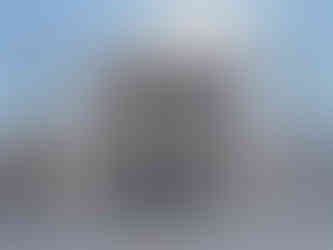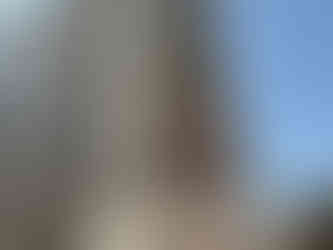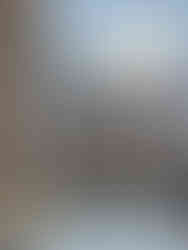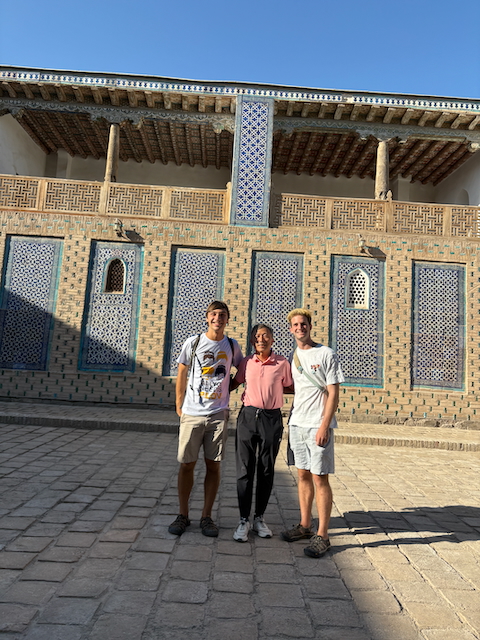Lessons on the Silk Road: Samarkand & Khiva
- Ian Rosenberg

- Jul 10
- 9 min read
This post is a continuation of the previous one, expanding on the lessons I learned in each of the three Silk Road cities I visited during my time in Uzbekistan. You can read that here, if you missed it.
The Registan
The Registan is the crown jewel of Samarkand. It’s kinda what people come to Uzbekistan to see (and the entrance fee reflects that…) It’s the most historical, most beautiful, most awe-inspiring thing in Samarkand. It’s a set of three madrassas, each built for a different purpose, across two ages of Uzbekistan’s history.

The first madrassa, the original, was built in the early 1400s. It is the epitome of Timurid architecture, with its grand gateway, elaborate tilework, and two-story layout. It was the madrassa to study at, with the great teacher being the khan Ulugh Beg himself, grandson of Timur. It was dedicated to the sciences, primarily, astronomy. The tilework is dark blue, reflecting the cosmos, with star patterns standing out from that background. On the inside was a green courtyard with lots of trees and areas to sit, where students and professors would socialize. As I described previously, madrassas had a dormitory-style living situation, and students would live at the madrassa.
Walking through the gigantic portal, you start to get a scale of just how impressive this building is. Above the door, there’s a tile inscription reading, in English, “The pursuit of knowledge is the duty of every Muslim man and woman.” I did bring up in the previous post that these places were secular. And for the most part, that is accurate. But there was always an Islamic underpinning to this—that these ideals of the pursuit of knowledge exists in an Islamic context. That thanks is always given to Allah for these discoveries, that in the end, though science is discovering the world, it’s still discovering the world that Allah created. It’s an interesting mix of religion and science that I think has been completely skipped over nowadays in favor of needing to believe in one and only one.
The inside had a museum to all the great discoveries of Uzbek astronomers, and in particular, to the works of Ulugh Beg. The museum had astronomical tools, maps of the earth, maps of the stars, and models of what a “meeting of the minds” may be like. It was very cool, and really gave a testament to the fact that the Timurids did not rule and conquer with the sword, rather with the pen and book.
The second madrasa, Sher Dor, was built two centuries after the Ulugh Beg one, after the Timurids went into a period of steady decline. The Ulugh Beg madrasa was starting to fall apart, and those in the city were disappointed that this grand time of learning and power was gone. They wanted to prove that they still had it, that they still had those expert artisan skills that were present at the peak of Samarkand. So they built a madrasa dedicated to those crafts, facing the Ulugh Beg one.
The gate of this madrasa is still steeped in mystery. Islam traditionally prohibits the portrayal of humans or animals in art, but above the gates are two faces inside of a sun, riding on a lion. Some think this may be a harkening back to the Zoroastrian days, where the sun held ritual, symbolic meaning. The lion may be a symbol of power, or it may be a pun on Sher Dor’s name, meaning “lion bearing.” But to this day, it’s rather unclear.
While Ulugh Beg’s madrassa was defined by science, reason, and logic, having a precise color scheme and patterns referential to that, the Sher Dor madrasa is all about being ornate. All about showing off the craft, reminding the Samarkandans (?) that their heritage, that their history, lives. Calligraphy, both with a brush on tilework, and made from the tiles themselves, are to be found all over. These are both religious sayings and secular sayings, just as was the case in Ulugh Beg’s madrasa. This madrasa held the schools of weaving, pottery, and calligraphy—the three arts defining the creative scene of Central Asia.
Finally is the Tilya Kori Madrasa. This one is fully religious, dedicated to the practicing of Islam in a structure worthy of awe. This mosque was built with the purpose of being a gathering place for Friday prayers and for Islamic study during the week, again, with the dormitory-style construction (though this time, in a single story). The mosque has an elaborate ceiling, with a gold and deep blue theme. It’s awe-inspiring, seeing the gilded calligraphy and admiring the intricate geometric patterns growing ever smaller as you zoom in on the ceiling. It’s really not an experience I can even describe or discuss; it’s one of those experiences you just have to be there for. To take in the majesty, artistry, and weight of all that is around you. To feel the presence of centuries of history from before this mosque’s construction, to see how it’s survived through time, and to be standing there, today, as someone in 2025. We are truly lucky to have the Registan Ensemble with us today in the amazing, restored state it is in now.
I just love Islamic architecture, and though I’d have considered the Alhambra to be the most beautiful building I’d ever seen before this trip, the Registan Ensemble trumps the Alhambra ten-fold. It has every detail, every pattern that the Alhambra has, but in vibrant, brilliant color. It’s mesmerizing to walk around, and to take in every detail, you’d need days. To learn about the significance of every pattern, a lifetime.
I should mention at this point that as we were taking photos inside the mosque, we ran into a Chinese tour group we became friends with on the plane from Bishkek five days prior. They were excited that I could speak Chinese, and we became fast friends for the 30 minutes we spent together. When we were taking our photos, they spotted me and asked if we could take a picture together as well. Of course! It was funny, at first, that we’d seen this family in two places. But it turns out that we’d see three other people from that flight around the various places in Uzbekistan, and we’d also run into this Chinese family again on two separate occasions in Khiva, a nine-hour drive away from Samarkand.
Our friend in (left) Samarkand, and (right) Khiva
I'm lucky Zack and I are both wearing different clothes... hygiene hasn't been at the forefront of our minds recently
Uzbekistan is not in its peak tourism season, and it’s not that touristy to begin with (despite the fact that nearly every place we went was designed for tourists). It’s just that everyone hits the same spots at about the same pace in about the same order, and those you enter with will be with you for the rest of the time. We found it entertaining, speaking with others in the hostels about mutual friends we’d met along our time, and running into people we’d met previously. It was such an odd community we’d formed…these people in Uzbekistan for only short term, all interested in the same history and monuments. We all knew each other, or of each other (there was one mystical biker we’d heard of several times but never met), despite being totally out of the community the locals have between themselves.
Timur Mausoleum, Shah-i-Zinda, and Ulugh Beg Observatory
These three sites are some of the secondary sites around Samarkand, still incredibly pretty and very historic, but not the must-sees that the Registan is.
We first went to the Timur Mausoleum. This is a beautiful blue dome with two minarets on either side, guarding the tombs of the great Timurid rulers and their families. Just like the mosque in the Registan, the mausoleum is intricately decorated, and awe-inspiring. Same goes for the Shah-i-Zinda, which we saw from a distance but didn’t pay to go into.
The Ulugh Beg Observatory would have been super cool if it still was standing, but now all that remains is the underground portion and a small museum adjacent. Like the Ulugh Beg Madrasa, the Observatory Museum had many scientific instruments and research findings done by Ulugh Beg and his students. But this site had also the gigantic sextant, dug deep into the ground, that Ulugh Beg and his students used to measure the position of the stars. The Sextant worked by funneling the light of the stars into a very specific spot, the angle of which could be measured using the sextant. The piece was so large that its error was practically negligible, assuming that the angle markings were placed correctly.

Ulugh Beg was able to predict the periods of the planets and asteroids to an accuracy that wouldn’t be matched until the advent of the telescope, three centuries later.
The remaining part of the sextant, consisting of a rail for observation that shot vertically into the now non-existent tower of the observatory, is shown below.

Khiva
I said most of what needs to be said about Khiva, but there’s a few loose ends.
First would be the silk museum. This museum is not included in the Khiva pass, but it was well worth the $2 we paid for entry. The “museum” part repeated a lot of the knowledge we’d already accumulated about the production and dying of silk, involving how the silkworms produce the cocoons, the massive amount of mulberry leaves needed to feed spinning silkworms, and the boiling process to create fiber. But the part that was really worthwhile was the hands-on aspect.
We got to spin the silk into a fiber that could be woven with, try our hands at a loom to create a scarf, and the most interesting was trying our hand at making our own silk carpet. The process was amazingly difficult for a first timer, and involved two rows of fibers to “anchor” the knots on. Unlike other fabrics, carpets are all individually knotted, allowing for those intricate patterns so indicative of the craft. When it comes to carpet quality, you get used to terms like “knots per square centimeter” and “double-knotted,” which both give you an indication into the quality of craftsmanship that went into making the carpet. Each carpet you’ll see in Uzbekistan is handmade, and the people have a real disdain for importing fake carpets from China—it undermines their business, of course!
The process of knotting involved taking a small amount of dyed silk string, running it through that “anchor,” grabbing a secondary anchor behind, and performing some crazy maneuver with your hand, rotating the strings all through each other, to create a knot. Then, you slide the knot into place and cut the extra fiber. Once the carpet is finished, all the fibers are cut to the same length (unless you’re making a 3D design) to ensure a smooth finish.
From left to right: Spinning, Weaving, Knotting
We also did a bread-making class in Khiva. Uzbekistan is famous for its non, bread clearly related to naan, which is cooked in a tandyr (same as an Indian Tandoor). The recipe was simple, just flour, salt, yeast, and water, and after sitting and rising for an hour, we rolled it out and stamped it. You stamp the center with a decorative bread stamp, usually giving some sort of geometric pattern or flower petals. The stamp is made from tiny needles all embedded in a wood base. Stamping not only adds to the visual appeal of the non, but also keeps the inside from rising. Non is shaped like a pizza, where the center is flat and the crust rises to be light and airy. If you didn’t stamp, the center would rise with the crust.
You then wet the edges of the bread and stick it to the wall of the tandyr, which is made of clay and straw, and heated by a cottonwood fire. The clay and straw holds heat very well, and maintains a very steady temperature. Cottonwood is a good material to burn, as it burns consistently at the right temperature to cook this bread. It was super cool seeing how the bread just sticks to the wall of the oven. And most pastries are baked like this—samsa, the Uzbek samosa is also stuck to the walls of a tandyr, giving a flaky, airy texture to the dish. I will say, it looks almost like magic, and I’m impressed they don’t lose more bread than they do to the flame in the center.
The last thing to say about Khiva is the dill noodles unique to the city. It seems that most of Central Asia is obsessed with dill, and frankly, I’m starting to get sick of it on literally everything, but these noodles were pretty cool. They are just regular noodles, but green because the dill is in the dough. You can’t see the individual needles; it’s blended that well. They’re served cold, which is certainly refreshing in the unforgiving Khiva heat. I can’t quite describe the sauce on top—it’s left my memory—but I remember being surprised by how it tasted. It’s not a cheese sauce or any kind of expected pasta sauce.

That sums up the Uzbek part of the Uzbekistan adventure, and I’ll move onto, in the next post, our few days in Karakalpakstan!

















































































Comments